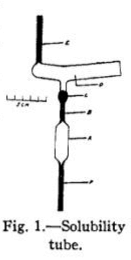 Although three rather extensive researches on the system gold-mercury have been published within the last ten years, the disagreement in the various results is most remarkable, particularly at lower temperatures. Quite recently rather precise results on the system silver-mercury, using a new type of solubility tube, have been published by Sunier and Hess;* it has therefore been thought advisable to redetermine the solubility of gold in mercury using the apparatus just referred to. This paper will present the results obtained on this system between the temperatures 80 and 200°.
Although three rather extensive researches on the system gold-mercury have been published within the last ten years, the disagreement in the various results is most remarkable, particularly at lower temperatures. Quite recently rather precise results on the system silver-mercury, using a new type of solubility tube, have been published by Sunier and Hess;* it has therefore been thought advisable to redetermine the solubility of gold in mercury using the apparatus just referred to. This paper will present the results obtained on this system between the temperatures 80 and 200°.
Materials.—Mercury which had been run through a five foot Meyer column containing mercurous nitrate and distilled in an all-glass apparatus at reduced pressure according to the method of Hulcott and Minchin was used in the first three determinations. The mercury collected in the evaporation of amalgams was used for the remaining determinations. Thousand-fine gold foil obtained from the Philadelphia Mint was used in preparing the amalgams of known concentration and in the first few determinations. The gold residues were used to make up the samples for the later determinations.
Apparatus.—The solubility tube, Fig. 1, a modification of the one used by Sunier and Hess, was made of pyrex glass and consisted of the sample tube, A, a capillary filter finely constricted at B, a glass wool filter, C, the upper tube, D, in which the amalgams were prepared and the capillary, E, which is used in the sampling of amalgams. This capillary had a diameter of one-half millimeter.
The solubility tubes were fastened to a rack made of square brass rod and built in a figure H; a side view of the rack is shown in Fig. 2. The tubes in this position are ready for sampling; when turned 180 degrees about the point P the tubes are in the shaking
position. The rack (holding four tubes) pivots about the point P and is held in either position by the lock L. The amalgams were shaken by pivoting the vertical rod R in the center and imparting a pendulum-like motion to the tubes on the lower end of the rod of such an amplitude as to completely transfer the amalgams from… https://pubs.acs.org/doi/pdf/10.1021/ja01381a009
